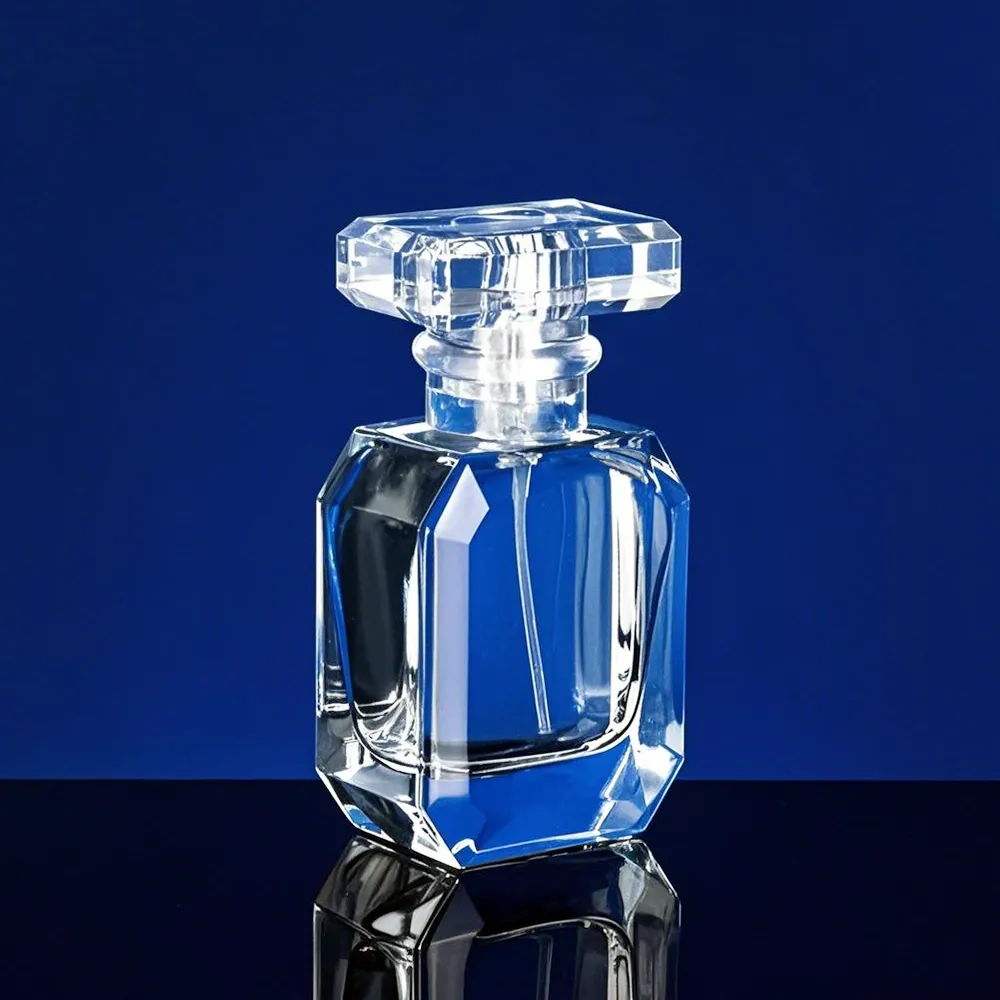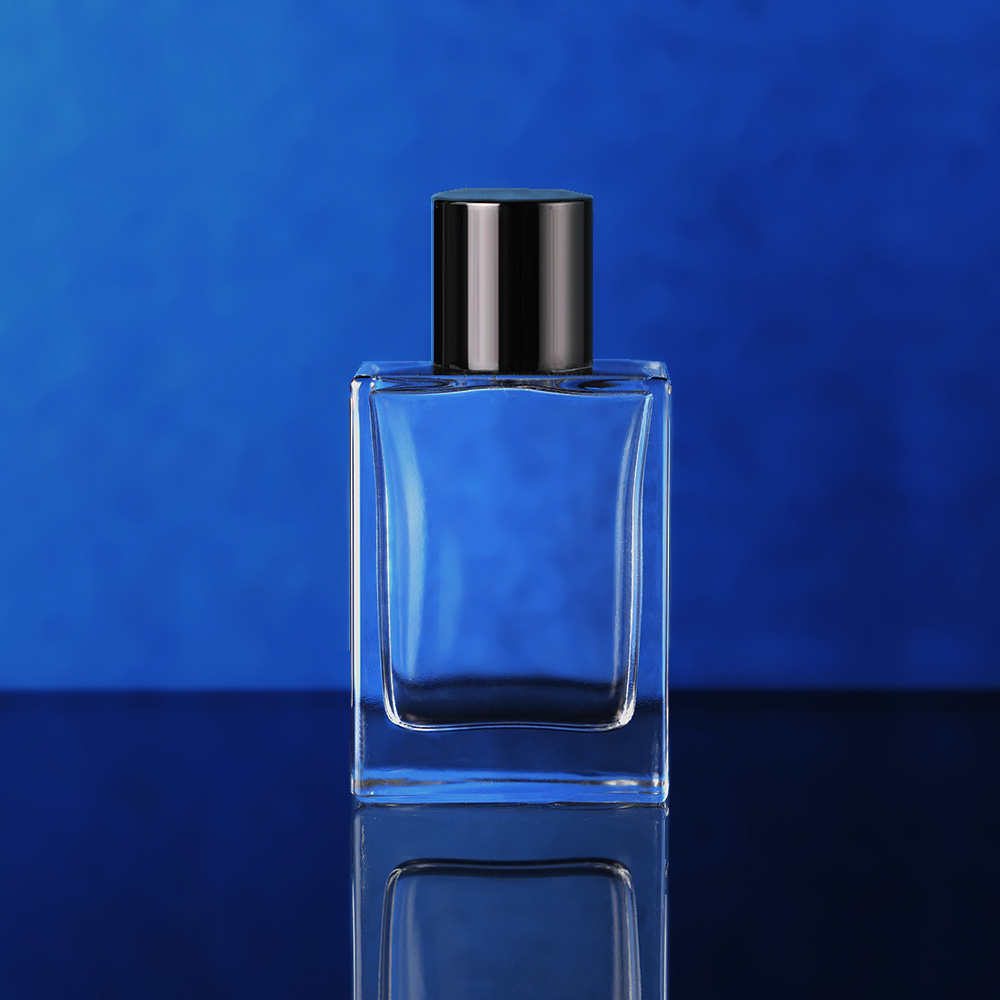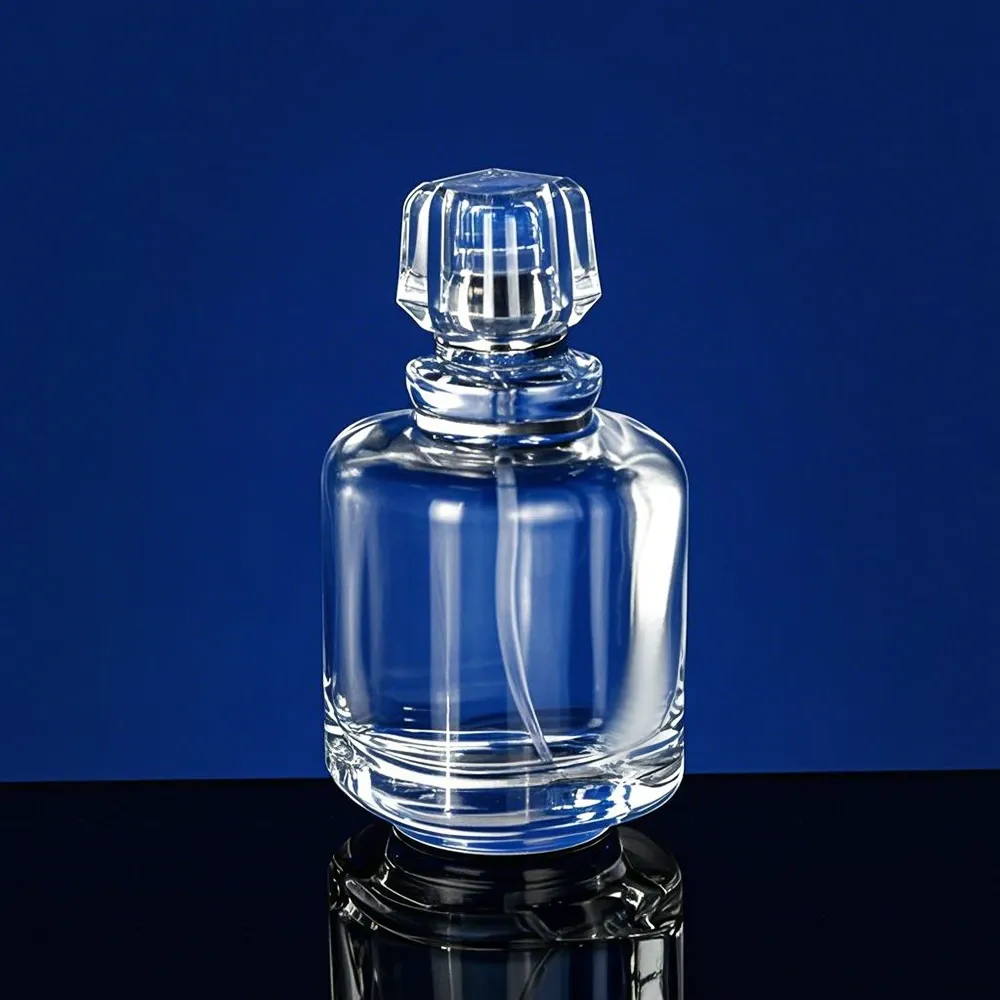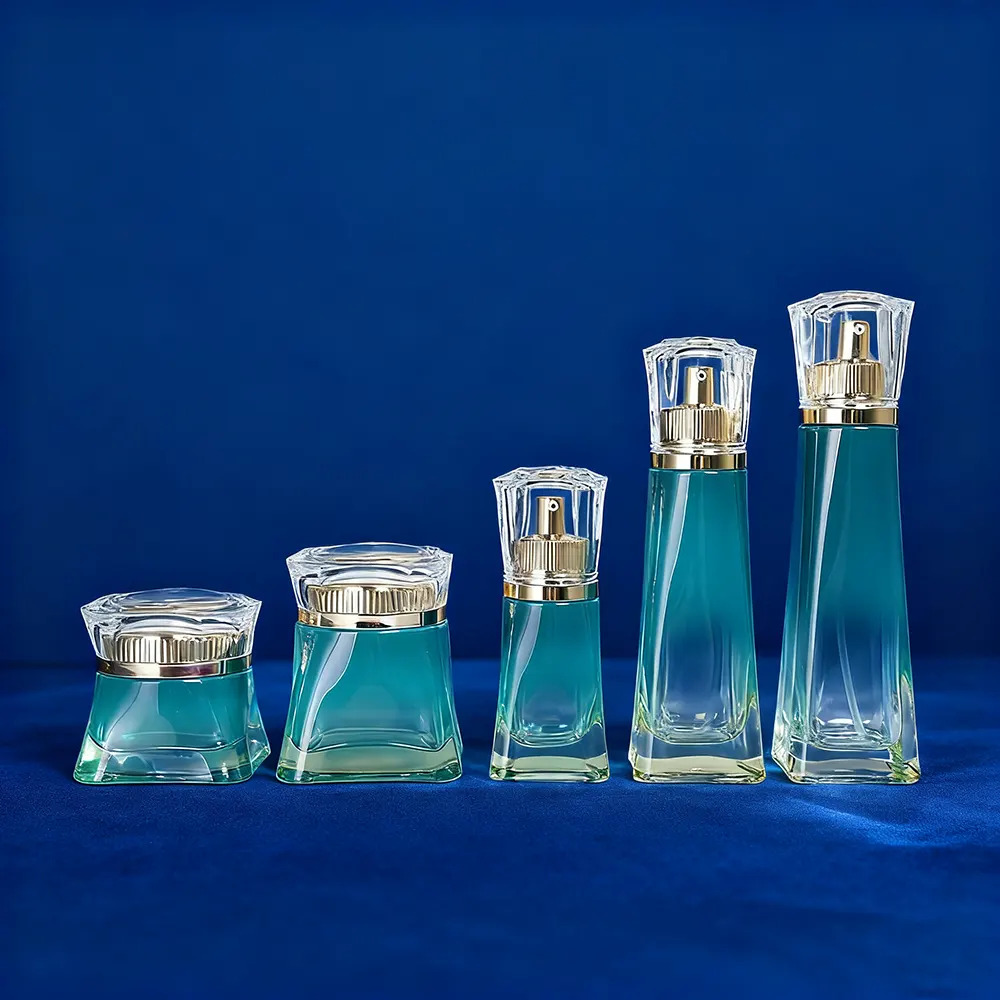
El papel fundamental de las empresas de envasado de cosméticos en el éxito de las botellas de vidrio para aceites esenciales
Tabla de contenido
1. Introducción: El imperativo estratégico de las empresas envasadoras en el lanzamiento de botellas de vidrio para aceites esenciales
En el dinámico mercado de los aceites esenciales, las empresas de envasado de cosméticos son socios estratégicos, cruciales para el éxito del lanzamiento de productos, especialmente en el caso de las botellas de vidrio para aceites esenciales. Este informe destaca su versátil contribución, abordando desafíos y oportunidades únicos. Se estima que el mercado mundial de aceites esenciales crecerá significativamente (entre 27 000 y 59 000 millones de dólares estadounidenses para 2030-2034). El envasado se convierte en una herramienta clave para el crecimiento, la diferenciación y el éxito en el mercado, y sirve como base para la primera impresión y la historia de la marca. Para marcas como VesseluxeEl embalaje de primera calidad es de suma importancia en los mercados competitivos.
2. Concepto y diseño: traducir la visión de la marca en botellas de vidrio funcionales para aceites esenciales.
El viaje del producto comienza con un concepto y diseño colaborativo, traduciendo la identidad de la marca a algo funcional y estéticamente agradable. botellas de vidrio para aceites esenciales.
2.1. Selección de materiales para la eficacia del producto y el posicionamiento de la marca
El vidrio es necesario para los aceites esenciales debido a su inactividad química, previniendo reacciones y preservando la lixiviación, la pureza, la resistencia y la vida útil.
- Vidrio ámbar: Estándares de la industria, bloquea más del 97% de la luz UV, ideal para aceites sensibles a la luz.
- Vidrio azul cobalto y verde: Ofrece seguridad UV moderada y atractivo estético.
- Vidrio violeta (vidrio Miron): Mejor protección bloqueando toda la luz visible excepto la violeta, ideal para aceites extremadamente sensibles, productos en forma de ultra-pramium pero de alto costo.
- Vidrio de borosilicato: Óxido de boro al 13–15%, que ofrece mejor resistencia al calor, a los productos químicos y al choque térmico, lo que lo hace ideal para aplicaciones exigentes.
- Vidrio sódico-cálcico: más económico y mango (90% vidrio comercial), pero menos duradero.
2.2. Diseño ergonómico y mecanismos de dispensación
Diseño ergonómico, en el que el agarre y el vertido son fáciles, mejora la melodía del usuario.
- Insertos cuentagotas: Importante para una dosificación precisa: el desorden puede provocar propagación y contaminación.
- Cuello específico: Diseños como el de botella 18DIN garantizan un acoplamiento preciso de la tapa, una dispensación coherente y sin fugas.
- Tamaño de la botella: Se prefiere un tamaño pequeño (5 ml-30 ml) para portabilidad y para reducir la oxidación, a menudo con tapa con cuentagotas tipo rollerball o euro.
2.3. Integridad del cierre y evidencia de manipulación
Las tapas son importantes para preservar los aceites y evitar fugas, ya que las grietas aceleran la oxidación.
- Banda manipulada-manipulada: necesario para la seguridad del producto, la manipulación de los consumidores y la protección de la reputación de la marca.
- Proceso de llenado: Durante el llenado, una tapa mal ajustada o un problema (por ejemplo, aceite, torque incorrecto en las roscas) pueden enfatizar fugas, mal funcionamiento y pérdida de potencia, diseño y fabricación resistentes.
2.4. Identidad de marca y percepción del consumidor
El embalaje actúa como embajador de la marca, afecta considerablemente la percepción del consumidor y sus decisiones de compra; el 66% de los consumidores prueban nuevos productos basándose completamente en el embalaje.
- Atractivo visual: Centrarse en prestar atención a la calidad del material, al acabado y a ampliar el valor del producto.
- Alineación de marca: La alineación del empaque con la imagen de marca refuerza la autenticidad, mientras que el color, la imaginación y la tipografía generan relaciones emocionales. El empaque ecológico es sinónimo de estabilidad.
- Estética cultural: El diseño debe ser compatible con las preferencias regionales; los mercados de Medio Oriente prefieren los diseños grandiosos, los mercados europeos prefieren la simplicidad y el respeto al medio ambiente, y el diseño asiático enfatiza la armonía.
2.5. Herramientas de colaboración y visualización avanzada
Para una cooperación eficaz es necesario comprender la identidad de la marca y los públicos objetivos.
- Prototipo rápido: El renderizado 3D y los vectores relacionados con la IA son fundamentales. Empresas como jarsking utilizan el dibujo 3D para la creación rápida de prototipos y la recurrencia del diseño, desarrollando el diseño en cuestión de horas y las muestras en cuestión de días.
- Superando desafíos: Estos dispositivos ayudan a garantizar la estabilidad de la base para formas orgánicas mediante la entrega precisa de material y modificaciones del molde.
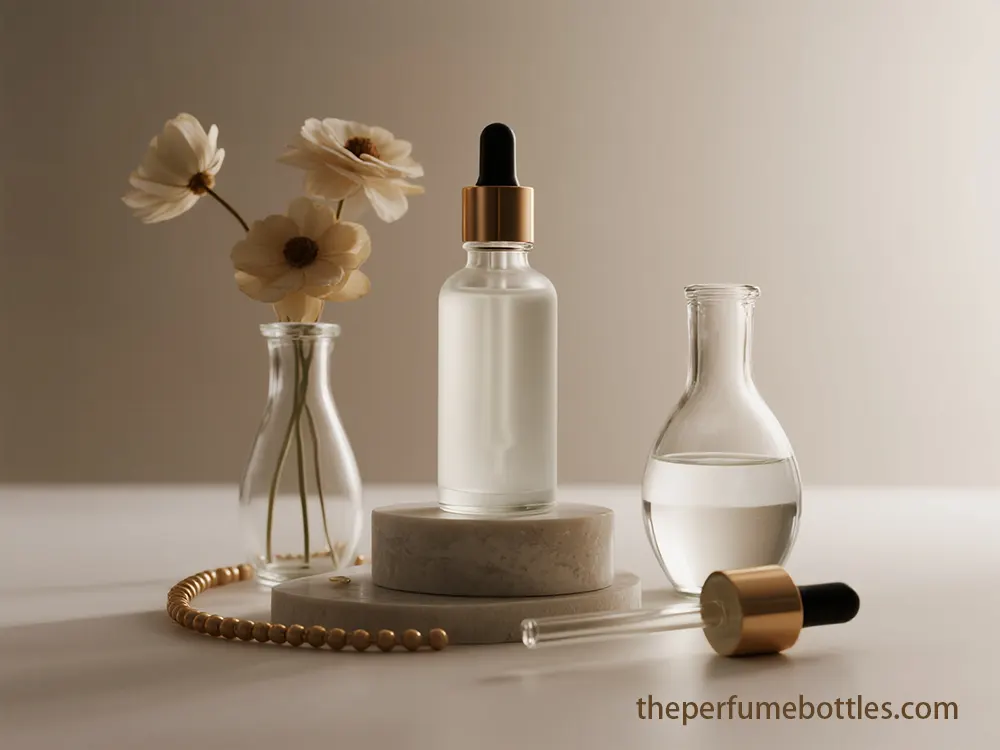
Obtén muestras gratis
3. Desarrollo técnico y creación de prototipos para envases de vidrio para aceites esenciales
Los productos de ingeniería y verificación garantizan la integridad, la seguridad y la vida útil.
3.1. Compatibilidad química y protección UV
El vidrio se prefiere por su inercia química, que evita la interacción con compuestos volátiles que degradan el plástico y el caucho. Las botellas de plástico pueden absorber sustancias químicas, alterar la calidad del aceite y aumentar el riesgo. Muchos aceites esenciales son fotosensibles; el vidrio más oscuro (ámbar, azul cobalto, verde) bloquea los dañinos rayos UV, prolonga la vida útil y conserva las propiedades terapéuticas.
3.2. Pruebas de integridad estructural
Las pruebas duras garantizan la flexibilidad física.
- Resistencia al choque térmico: Evalúa cómo las botellas manejan fluctuaciones rápidas de temperatura (por ejemplo, 60–90 ° C a 0-20 ° C) sin desintegrarse, lo cual es significativo para el transporte y el almacenamiento. 64, ASTM C149 prueba especialmente los contenedores de vidrio comerciales para detectar choque térmico.
- Resistencia a caídas y presión: Las botellas aseguran los efectos físicos y la presión interna.
3.3. Herramientas avanzadas de diseño y simulación
- Prototipo rápido: La impresión 3D (SLA, FFF) acelera el desarrollo del diseño, permitiendo la evaluación física de la estética y la estructura antes de la producción, la adaptación del presupuesto y el lanzamiento.
- Análisis de elementos terminales (FEA): La tensión en el diseño del vidrio debido a la carga estable y transitoria (presión interna, choque térmico) identifica áreas problemáticas y adapta los diseños para la luz o el rendimiento antes de la fabricación.
3.4. Procesos de validación para nuevos sistemas de cierre
El sistema de cierre es importante para un sellado hermético, que protege contra el riesgo de contaminación por aire. Los componentes inflamables o un llenado inadecuado pueden causar fugas y fallos de funcionamiento. Los aceites esenciales con tapa y cuello de 18 DIN son el estándar de la industria para frascos con gotero.
3.5. Normas industriales y caracterización química
- Norma ISO y ASTM: Establezca métodos para la prueba y calibración de materiales de vidrio, garantizando la calidad y el rango de tolerancia. La norma ASTM es común en EE. UU. (FDA-Panchayat para productos farmacéuticos), mientras que la norma ISO es predominante en Europa y Asia.
- Caracterización química del aceite esencial: La cromatografía de gases-espectrometría de masas (GC-MS) identifica componentes, mide concentraciones, confirma la autenticidad y detecta la adulteración, lo que garantiza los beneficios médicos y el cumplimiento normativo.
3.6. Validación integral del embalaje
La verificación de envases requiere un plan completo, que incluye los criterios de aceptación, un tamaño de muestra suficiente y la peor posición. Las estrategias deben alinearse con normas como ISO 11607-1, ISO 11607-2 e ISO 11607-3, especialmente para el diseño de barreras estériles. Los estudios de Aajing y las pruebas de extraíbles/lechelles también son importantes para los sistemas de cierre de envases.
4. Fabricación y control de calidad de botellas de vidrio para aceites esenciales
Vidrio de alta calidad frascos de aceites esenciales Dependemos de una fabricación avanzada, una decoración precisa y un estricto control de calidad.
4.1. Técnicas de moldeo de precisión
Las botellas se producen utilizando tecnologías de formación avanzadas, como soplado-soplado, prensado-soplado y prensado-soplado de cuello estrecho (NNPB), lo que permite una distribución precisa del vidrio y envases más livianos y resistentes.
4.2. Proceso de recocido crítico
Tras su formación, las botellas pasan por el túnel en las bhattas para eliminar las tensiones internas mediante un enfriamiento rápido, lo que aumenta considerablemente su resistencia y durabilidad. En el caso del vidrio sódico-cálcico, las botellas se calientan a 510-550 °C y se enfrían gradualmente, un proceso que dura entre 20 minutos y 2 horas. Un recocido adecuado puede aumentar la resistencia al impacto en un 300 % y soportar fluctuaciones de temperatura de 50-70 °C.
4.3. Diversos métodos de decoración
La adaptación realza la belleza a través del atractivo y la marca:
- Serigrafía, estampación en caliente, grabado láser, aplicación delicada, pintura en aerosol, esmerilado, galvanoplastia, tampografía, metalización, transferencia en caliente y makkashi.
4.4. Protocolo de control de calidad de varios pasos
Se aplican protocolos de control de calidad estrictos de varios pasos:
- Inspección de materia prima: Comprueba la pureza, la composición y la humedad.
- Monitoreo durante el proceso: Temperatura, simetría y monitoreo continuo de moldes.
- Inspección postproducción: Inspección 100% manual y automática para precisión dimensional, defectos visuales (burbujas, grietas, rayones) y pruebas funcionales (efecto, presión, choque térmico, sellado, resistencia química).
4.5. Sistemas avanzados de inspección automatizada
Los sistemas automáticos son indispensables para detectar defectos con alta velocidad y precisión. Utilizan cámaras de alta resolución, sensores especiales, iluminación LED y algoritmos de inteligencia artificial/aprendizaje automático para identificar defectos minúsculos (microcruces, burbujas, deformidades, roscas rotas) con una precisión de hasta 0,1 mm.
4.6. Control estadístico de procesos (CEP) para la mejora continua
El SPC supervisa y controla los procesos de construcción utilizando datos en tiempo real para garantizar la eficiencia y la coherencia de la calidad. Esto controla el diagrama de control para identificar la variación general por razones atribuibles, detectar el problema inicial, reducir el desperdicio y mejorar la capacidad del proceso.
4.7. Impacto de las tolerancias de fabricación en las operaciones posteriores
La precisión dimensional afecta la eficiencia de la línea de llenado y la experiencia del consumidor. La desviación selectiva frena y afecta la compatibilidad del dispensador, lo que provoca fugas o un sellado inadecuado.
4.8. Iniciativas de eficiencia energética
Los fabricantes reducen el consumo energético y las emisiones:
- Modernizar los hornos, aplicar recuperación de calor residual y optimizar el uso de agua y electricidad.
- Utilizando Cullet Cullet (25–90% de la mezcla del lote), que reduce la temperatura de fusión y las necesidades energéticas.
- El diseño liviano de la botella también reduce la energía durante la fusión y la formación.
4.9. Desafíos en la consistencia del color para el vidrio decorado
Mantener colores continuos en grandes producciones, especialmente con recubrimiento por pulverización o serigrafía, es un desafío. Factores como la variedad del lote de tinta/pintura, el espesor de la aplicación y el tratamiento afectan el color final, lo que requiere una estricta supervisión durante el proceso.
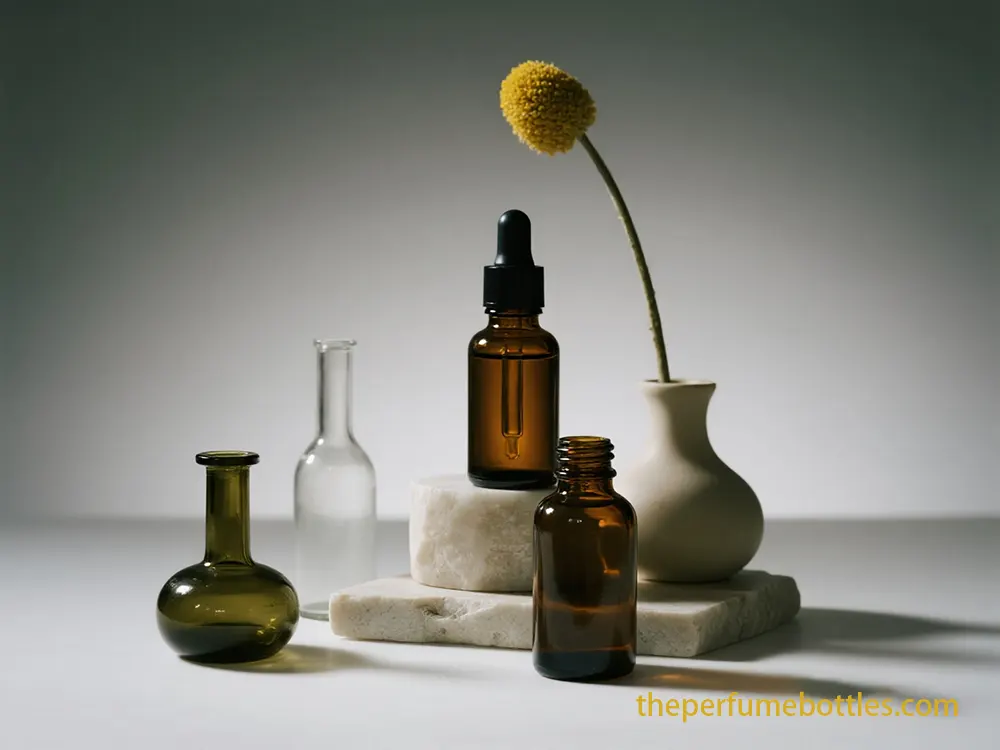
Obtén muestras gratis
5. Gestión de la cadena de suministro y logística para envases de vidrio para aceites esenciales
La adaptación de la cadena de suministro de botellas de vidrio delicadas para aceites esenciales es importante para la eficiencia, la rentabilidad y la responsabilidad del mercado.
5.1 Optimización del abastecimiento
- Selección de materiales: Vidrio sódico-cálcico, borosilicato o de color (ámbar, azul cobalto, verde), principalmente para inactividad química y protección UV. El vidrio violeta ofrece mayor protección para productos ultra-Permina.
- Estructura de costos y selección de proveedores: Los costos totales de entrega incluyen materias primas (arena de sílice, carbonato sódico, piedra caliza, collalets), cuya inestabilidad afecta los precios. Los compradores B2B evalúan a los fabricantes en cuanto a control de calidad (ISO, GMP), adaptación, cantidad mínima de pedido (5000-10 000 unidades para pedidos personalizados), plazo de entrega y suministro de muestras. Las relaciones a largo plazo, especialmente al crear centros como China, garantizan una calidad constante.
- Componentes específicos y cerrados: Importante para la integridad y seguridad, incluidos goteros precisos, reductores ORFIS, manipulación y tapa a prueba de niños, incluidas fugas, contaminación, caídas e ingestión casual.
5.2. Gestión de inventario y optimización de la distribución global
- Embalaje protector: Una estrategia multicapa reduce las roturas: embalaje individual (burbuja, fundas de espuma), almohadillas de amortiguación, insertos moldeados a medida (p. ej., EPS, que reduce la pérdida al 37%), fibra moldeada con pulpa o separadores de cartón corrugado. Es importante rellenar los huecos con bolitas de poliestireno, cojines de aire o papel de embalaje Crumport. También es importante reforzar el doble embalaje y los puntos débiles.
- Almacenamiento: Las botellas almacenadas en un ambiente seco, estable y con temperatura y humedad controladas evitan la expansión y contracción del vidrio y protegen el envase. El apilamiento estratégico (palatización, interbloqueo) aumenta la estabilidad. La protección de la luz solar directa es necesaria para los aceites fotosensibles.
- Transporte: Para reducir las vibraciones, se requieren cambios rápidos y vehículos con control de temperatura para evitar la suspensión neumática. El artículo debe asegurarse con correas, barras de carga o bolsas de aire. Es importante una distribución uniforme del peso y un etiquetado claro de "delicado".
5.3. Estrategias de mitigación de riesgos para las cadenas de suministro globales
- Diversificación y excesos: Reduce la dependencia de proveedores únicos que recurren a dos o más proveedores para obtener componentes importantes, y reduce los riesgos derivados de conflictos geopolíticos, desastres naturales o problemas laborales. La logística de reaprovisionamiento puede reducir el riesgo y los plazos de entrega. Los contratos a largo plazo y las reservas de reserva también son importantes.
- Monitoreo activo y planificación informal: La evaluación continua de riesgos, la supervisión del rendimiento de los proveedores (estabilidad financiera, calidad, continuidad del negocio) y el desarrollo de planes de acción son necesarios. El uso de equipos con IA para la planificación estratégica y el análisis futuro ayuda a predecir riesgos y a reaccionar con rapidez.
5.4. Función de las plataformas de visibilidad de la cadena de suministro
- IoT y digitalización: Las plataformas utilizan sensores IoT, etiquetas RFID y sistemas de código de barras para una transparencia integral en tiempo real. El dispositivo IoT monitoriza la posición (temperatura, humedad, impactos y vibraciones) de la carga y proporciona rastreo GPS. Estos datos permiten tomar decisiones activas, identificar obstáculos y facilitar la inspección y la tramitación de reclamaciones de forma inmediata.
- Cadena de bloques: Búsqueda de registros irreversibles, trazabilidad ampliada y transacciones confiables, importantes para la integridad y el cumplimiento de los aceites esenciales.
5.5. Análisis costo-beneficio de los métodos de envío (especulativo/predictivo)
El transporte marítimo es un transporte masivo pero lento. El transporte aéreo ofrece una distribución rápida, pero a un alto costo, especialmente con control de temperatura y un embalaje protector resistente para vidrio delicado. Esta opción equilibra los riesgos de la rentabilidad, la rapidez de comercialización y las fluctuaciones ambientales y de averías. El petróleo de alto valor o con plazos de entrega urgentes puede justificar el transporte aéreo.
5.6. Impacto de los acontecimientos geopolíticos en las cadenas de suministro de vidrio
Los eventos geofísicos (guerra comercial, aranceles, conflictos, restricciones) afectan gravemente las cadenas de suministro de vidrio, incrementan el costo de las materias primas y causan interrupciones en la producción, lo que obliga a los proveedores a diversificarse. Los cortes de energía debidos a las altas temperaturas, por ejemplo, resaltan la necesidad de una mayor visibilidad de la cadena de suministro y de proveedores alternativos.
6. Cumplimiento normativo y sostenibilidad en envases de vidrio para aceites esenciales
Las empresas de embalaje brindan una ayuda importante para sortear normas complejas e integrar prácticas duraderas.
6.1. Cumplimiento normativo
- Desarrollo de la normativa de la FDA (2024): claridad de etiquetado actualizada (fuentes estandarizadas, sin afirmaciones médicas sin símbolos de advertencia, nomenclatura INCI, aprobación de la FDA), ampliada a aceites enfocados para envases a prueba de niños (por ejemplo, esbilion, menta, aceite de árbol de té) y seguridad del material para seguridad.
- CPSC y embalaje a prueba de niños (PPPA): La CPSC de EE. UU. aplica la PPPA, que obliga a usar envases a prueba de niños para productos domésticos peligrosos, incluidos algunos aceites esenciales. Se han retirado del mercado productos no destinados al transporte.
- Etiquetado de la Ley Federal de Materiales Peligrosos (FHSA): La FHSA exige un etiquetado específico para los aceites esenciales peligrosos, que requiere detalles del importador/fabricante, nombres generales/químicos, términos de señalización (“peligro”, “precaución”), declaraciones peligrosas/precautorias, instrucciones de primeros auxilios y “mantener fuera del alcance”.
- Seguridad del material y protección UV: El vidrio es el preferido por su inactividad, que previene las reacciones químicas y la lixiviación. El vidrio ámbar y el vidrio cobalto ofrecen protección UV, mientras que el ámbar ofrece una mayor protección contra la degradación.
6.2. Sostenibilidad en los envases de vidrio para aceites esenciales
- Vidrio reciclado postcondensación (PCR): El vidrio se recicla permanentemente. El uso de vidrio PCR (bastante) ahorra materias primas y reduce el consumo de energía (2,5 % por cada 10 % de aumento en Kullet). Los desafíos incluyen la limitación de la alta calidad del PCR de grado alimentario, la calidad inconsistente de los materiales y los altos costos.
- Innovación ligera: La industria ha logrado avances importantes, manteniendo la masa de la botella y al mismo tiempo manteniendo la integración.
6.3. Certificación y demanda de sostenibilidad por parte de los consumidores
- Certificación Certificación: Un estándar riguroso y con base científica que evalúa la salud de los materiales, la circularidad del producto, la protección del aire limpio y el clima, el liderazgo en agua y suelo, y la equidad social. Se alinea con los objetivos de la Unión Europea para todos los envases para 2030.
- Certificación B Corp: El desempeño social y ambiental refleja altos estándares de responsabilidad y transparencia. Empresas como Sustainable Packaging Industries (SPI) y JBM Packaging han obtenido la certificación B Corp.
- Creciente demanda de los consumidores: El 90% de los consumidores son más propensos a comprar marcas con empaques permanentes; el 54% compra estos productos de forma consciente. Se espera que aproximadamente 10 de cada 7 consumidores adopten el empaque para 2025, y el 43% pagará más. La clara estabilidad refleja una fuerte preferencia (70%) por la etiqueta.
- Ley de responsabilidad extendida del fabricante (REP): La nueva legislación sobre REP aumenta la demanda de transparencia en los materiales y el cumplimiento normativo por parte de los fabricantes de envases, exigiendo datos detallados sobre los tipos de envases, su peso y los materiales reciclados. Los fabricantes que proporcionan documentación detallada obtienen ventajas competitivas.
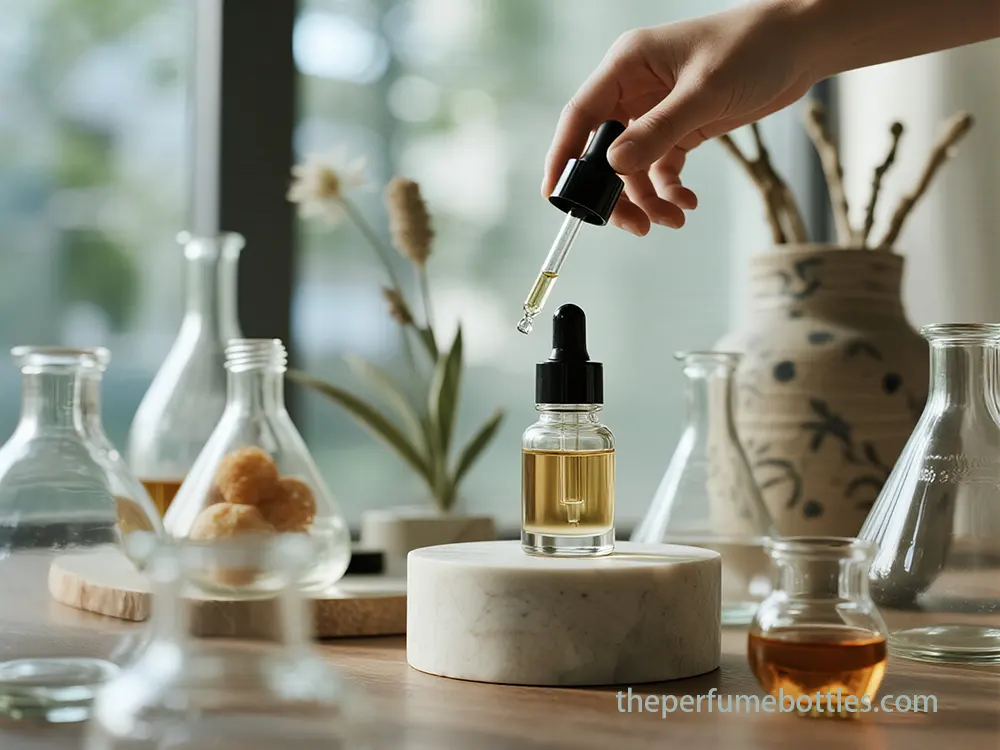
Obtén muestras gratis
7. Asociación estratégica: acelerar la comercialización y mejorar la rentabilidad
Las empresas de envasado actúan como asesores estratégicos, recomiendan tendencias del mercado, se adaptan a los costos y aplican de manera rápida y eficiente una producción ajustada para un lanzamiento eficiente de productos con aceites esenciales.
7.1. Tendencias e inteligencia del mercado
La industria de los aceites esenciales es un motor fundamental para el bienestar general, con un 68,7 % de adultos que los consumen regularmente. Se estima un crecimiento significativo del mercado, impulsado por las preferencias de los consumidores por la salud natural, la vida a largo plazo y el bienestar general. Las tendencias de empaquetado priorizan la personalización y la estabilidad mediante materiales ecológicos y un diseño minimalista.
7.2. Las empresas de embalaje como consultoras estratégicas
Las empresas de embalaje ofrecen servicios de valor añadido más allá de la fabricación. Ofrecen asesoramiento sobre las tendencias del mercado, optimizan las estructuras de costes y aplican una producción ágil. El embalaje es fundamental para establecer la identidad de la marca, comunicar valores y contar historias. Un embalaje especialmente atractivo sirve como una potente herramienta de marketing en redes sociales, ya que integra elementos interactivos para códigos QR o funciones de realidad aumentada. La interacción proporciona datos/visualización para impulsar los materiales de marketing.
7.3. Metodologías de optimización de costos
- Ingeniería de Valor (VE) y Análisis de Valor e Ingeniería de Valor (VAVE): Los enfoques sistemáticos mediante el uso de materiales eficientes, la adaptación del diseño estructural, la reconstrucción de materiales y el embalaje secundario reducen los costos del producto (generalmente entre un 5 y un 40 %) sin comprometer la calidad ni la función.
- Ahorro de costes indirectos: Poco espacio de almacenamiento, menores costos de transporte gracias a materiales más livianos y menor tiempo de embalaje.
- Mayor resistencia del embalaje: VE puede mejorar la resistencia del embalaje para reducir los daños durante el transporte, lo que reduce significativamente los costos debido a la baja probabilidad de rotura.
- Especialización y Datos: Los ingenieros de embalaje utilizan datos y modelos propietarios para identificar materiales ideales, estandarizar SKU y optimizar la operación, y reportan ahorros de entre el 8 % y el 16 %.
- Redisine y optimización: La reutilización de los envases y la optimización de la forma pueden generar un contenido adecuado y una deficiencia de residuos; la reducción del 8% en el peso de la botella puede eliminar ~ 1,6 millones de toneladas de contenido al año, posiblemente ahorrando más de $ 3 mil millones de dólares.
7.4. Metodologías de producción ágiles y velocidad de comercialización
- Fabricación esbelta: Optimiza la cadena de suministro para eliminar desperdicios, crea un flujo constante y responsable, y produce para exigir el menor costo al menor costo. Esto resultó en un lanzamiento fluido, mejoras en la calidad y una práctica eliminación.
- Matrices de intercambio de un minuto (smed): Un funcionamiento lean de un funcionamiento lean, externo y optimizado de actividades, separando, separando, un funcionamiento lean para reducir actividades individuales.
- Beneficios de la implementación: La aplicación de SMED y la integración de MES/CMM pueden reducir el tiempo promedio de cambio entre un 20 % y un 30 % en tres meses y entre un 40 % y un 50 % en un plazo de 6 a 12 meses. Los estudios de caso muestran una disminución significativa en el tiempo de estudio, lo que aumenta la eficiencia general del equipo (EO) y reduce los costos de mano de obra.
7.5. ROI de las alianzas estratégicas de embalaje
El Servicio de Alianzas Estratégicas de Prasad facilita la diversificación, el acceso a nuevos mercados, la adaptación de recursos y una mayor creatividad e innovación. Medir el ROI es fundamental para la rentabilidad y la toma de decisiones informadas, ya que proporciona información sobre los costos directos e indirectos. La evaluación periódica y los objetivos de propósito promedio monitorean el ROI y garantizan la alineación con los objetivos estratégicos. Las alianzas sólidas en el sector manufacturero mejoran la calidad de los productos gracias a la transparencia de la cadena de suministro, la reducción de interrupciones, la entrega más rápida, los valores compartidos y un riguroso control de calidad.
7.6. El papel del análisis de datos en la previsión de la demanda del mercado
El análisis de datos para la previsión de la demanda permite tomar decisiones precisas sobre producción, inventario y ventas a partir de datos históricos, algoritmos de IA, modelos estadísticos e información en tiempo real (TPV, transacciones en línea). Reduce el exceso de inventario. Para las empresas de embalaje, la combinación de métodos cuantitativos (p. ej., series temporales) y cualitativos (opinión de especialistas) es esencial para una previsión precisa.
8. Innovaciones emergentes en envases de vidrio para aceites esenciales
El futuro del diseño y la funcionalidad de las botellas de aceites esenciales está determinado por las tendencias futuras y los avances tecnológicos.
8.1. Tratamientos superficiales avanzados para una mayor protección y funcionalidad
- Protección UV personalizada: Vidrio ámbar con un 98 % de bloqueo de rayos UVB. Se están detectando técnicas avanzadas, como la deposición de capas atómicas (ALD), para ajustar correctamente la longitud de onda bloqueada por rayos UV sin comprometer la transparencia, lo que ofrece una sofisticada prevención de la fotocardación.
- Recubrimientos antimicrobianos a base de aceites esenciales: Los aceites esenciales poseen propiedades antimicrobianas subyacentes. Clear Research (agosto de 2024) desarrolló una novedosa superficie antibacteriana, que incluía aceite esencial de eucalipto en micronanoesferas, que logró una reducción de la contaminación del 99,98 %, lo que sugiere una posible prevención de la formación de biopelículas.
- Recubrimientos oliofóbicos e hidrofóbicos: Estos recubrimientos forman superficies resistentes al aceite, antihuellas y ricas en agua, ampliamente utilizadas en la electrónica de consumo.
- Tratamiento de intercambio iónico con plasma (P-IET): Un proceso sinérgico P-IET de vidrio de borosilicato tipo I crea superficies hidrófilas sostenibles, lo cual es importante para una dispensación eficiente y sin desperdicios de medicamentos a base de agua, que se pueden adaptar a dosis precisas y exactas.
8.2. Integraciones de envases inteligentes para una mayor participación del consumidor y la seguridad de la cadena de suministro
Para garantizar la autenticidad y la trazabilidad, se utilizan NFC/RFID: la comunicación de campo (NFC) y la identificación por radiofrecuencia (RFID) en áreas de alto valor para la autenticación de productos y la trazabilidad de la cadena de suministro. También se utilizan algoritmos de contador y criptográficos dinámicos.
- Capacidad de experiencia del consumidor: El embalaje inteligente (código QR, etiqueta NFC, AR) proporciona información detallada del producto, instrucciones de uso y recordatorios de dosis, una interacción profunda con el cliente y aumenta la experiencia de desempaquetado.
- Implicaciones éticas: Los datos de envases inteligentes basados en IA plantean importantes perspectivas morales sobre la privacidad, la seguridad, la equidad y la responsabilidad. La recopilación, el uso y el almacenamiento de información sensible son fundamentales.
8.3. Nuevas formulaciones de vidrio sostenible y consideraciones ambientales
- Vidrio biodegradable: En marzo de 2023, se lanzó una nueva familia de vidrio ecológico a partir de aminoácidos y péptidos. Se trata de vidrio de origen biológico, reciclado y biodegradable, que aborda la no biodegradabilidad del vidrio tradicional. Sin embargo, actualmente está lejos de su comercialización masiva.
- Vidrio ultraligero: En más de 50 años, se han fabricado envases de vidrio un 30% más ligeros y con un 70% menos de consumo energético.
- El vidrio como opción permanente: El vidrio es 100 % reciclado y puede reciclarse indefinidamente sin perder calidad. Requiqling reduce el consumo de energía y las emisiones de CO2. Consures elige envases de vidrio por su supuesto respeto al medio ambiente.
- Sistema de cierre y recarga ecológico: La innovación incluye tapas biodegradables, tapas de bambú y goteros de PP reciclables. Las soluciones rellenables y reapropiables para reducir los envases de un solo uso están ganando terreno.
Vesseluxe está a la vanguardia de estas innovaciones, ofreciendo soluciones a medida que combinan técnicas de última generación con prácticas sustentables para distribuir envases que no solo protegen y preservan los aceites esenciales, sino que también mejoran la presencia de la marca y resuenan con un consumidor sensato.
Comentarios
Categorías de productos
Botellas en oferta
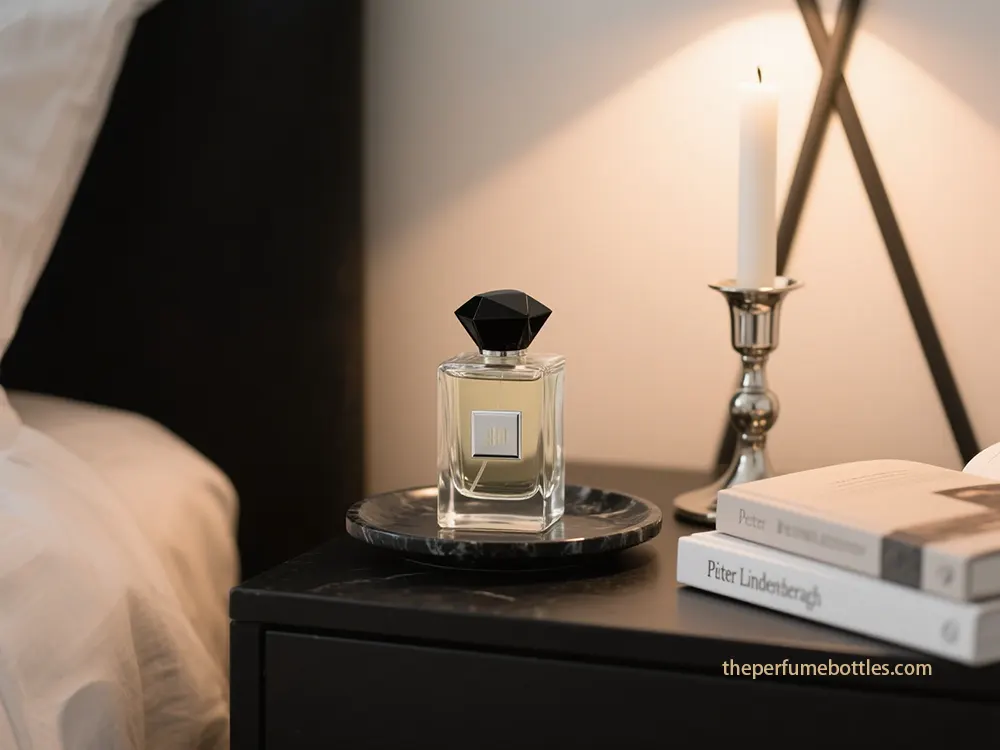
El papel de la sostenibilidad en el diseño moderno de frascos de perfume personalizados
La sostenibilidad impulsa el diseño moderno de frascos de perfume personalizados. Explora los materiales ecológicos, la fabricación avanzada, los sistemas rellenables y las tendencias de envases de lujo de Vesseluxe.

Caso práctico: Frasco gotero de vidrio personalizado para una marca alemana de aceites esenciales
Frascos cuentagotas de vidrio personalizados para aceites esenciales alemanes: decoración avanzada, control de calidad estricto y acabado impecable para un empaque de marca premium.

Guía de diseño y fabricación de frascos de perfume con forma de mariposa
Descubra el arte, las tendencias y los materiales del diseño de frascos de perfume con forma de mariposa. Consejos de expertos en fabricación B2B para crear un empaque de fragancias único, impactante y cautivador.
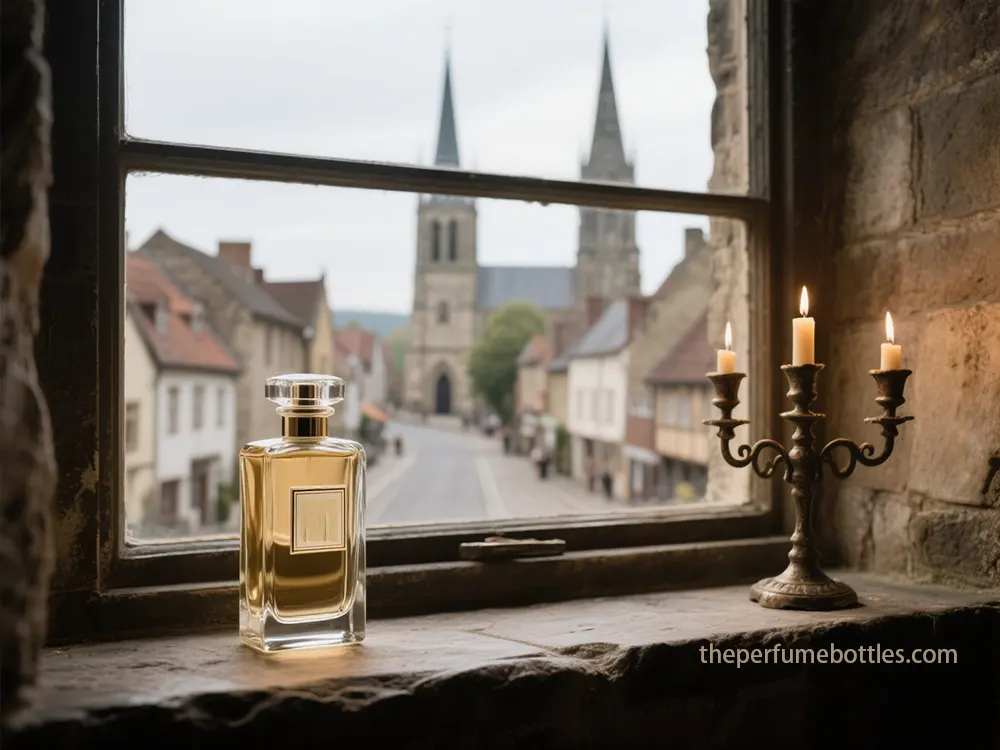
Forma y material de la botella de perfume para marcas y proveedores mayoristas de botellas de perfume de vidrio
La forma y el material del frasco de perfume son estratégicos para la identidad de marca, la integridad del producto y la sostenibilidad.

Cómo abrir un frasco de perfume y rellenarlo: consejos y trucos paso a paso
Desde cómo abrir una botella de perfume hasta aprender a transferir su aroma favorito sin derramarlo, este artículo lo guía en todo.
- +86 186 5178 1159
- [email protected]
- Lunes a domingo de 7:00 a 21:00
Etiquetas
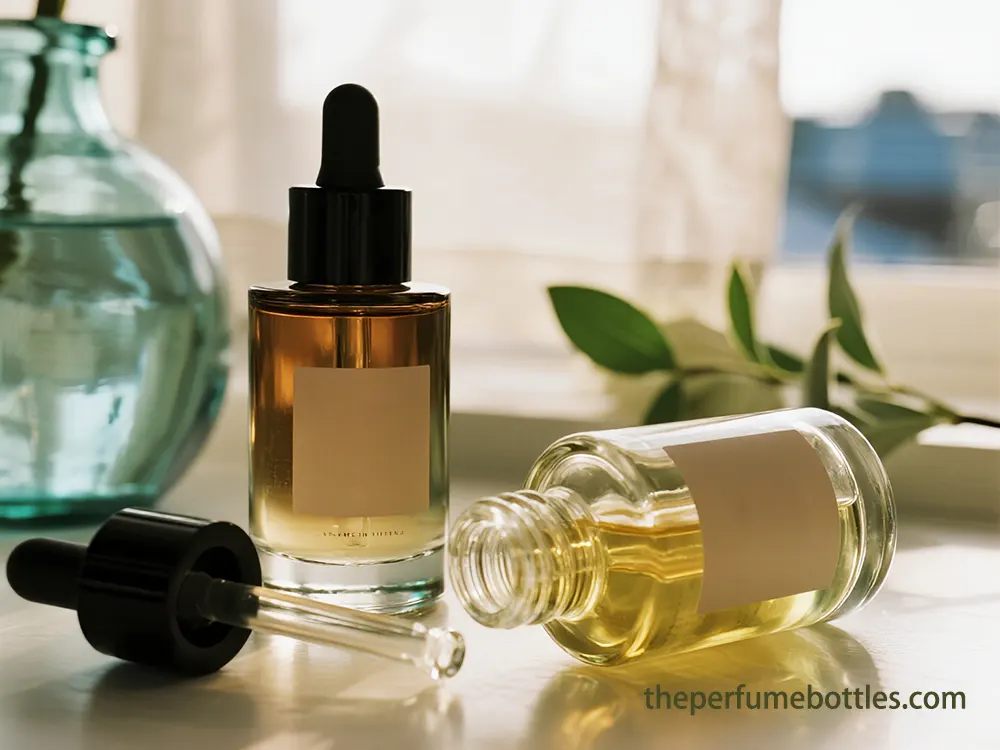
Cómo elegir el proveedor adecuado de frascos cuentagotas: Por qué es más importante que el precio
Aprenda a elegir el proveedor adecuado de frascos goteros de vidrio centrándose en la calidad, el cumplimiento, la estabilidad del suministro y la sostenibilidad más allá del costo.

Caso práctico: Cómo una marca de fragancias independiente portuguesa eligió a Mosteb como proveedor de frascos de perfume de vidrio
Una marca de fragancias se asocia con nosotros como proveedor de frascos de perfume de vidrio, resolviendo problemas de escarchado y ajuste de tapas con ingeniería precisa y una producción personalizada estable.
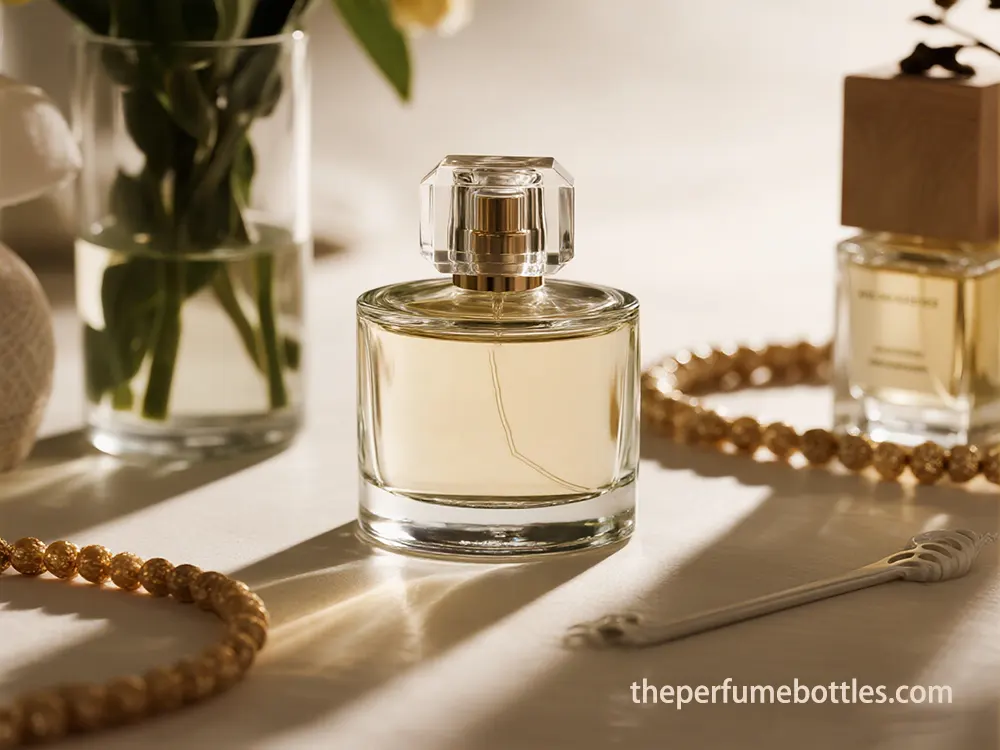
Un marco estratégico para la selección de un proveedor de frascos de perfume de vidrio
Encuentre su proveedor estratégico de frascos de perfume de vidrio con esta guía, que muestra cómo el socio adecuado impulsa la velocidad y el crecimiento escalable de las marcas de fragancias.

Estudio de caso: Nuestra fábrica de botellas de vidrio con rodillo entregó envases para una marca de aceites esenciales
Un estudio de caso sobre cómo una fábrica de botellas de vidrio enrollables resolvió los problemas de estabilidad de rodadura y durabilidad de cuellos delgados para entregar botellas premium confiables y sin fugas.

